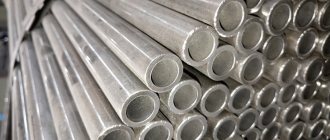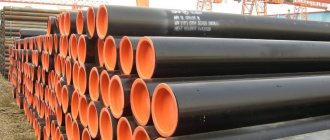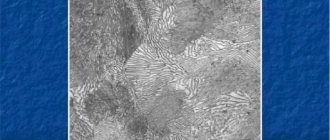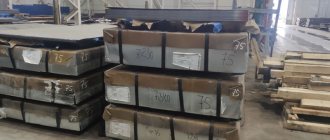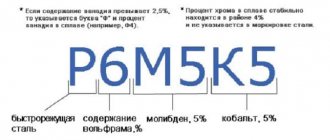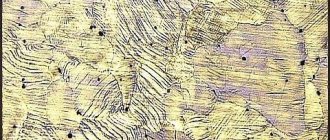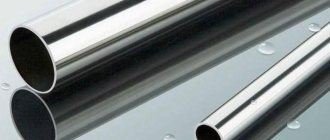Explanation and characteristics of steel steel 35
The number 35 indicates the carbon content, which is 0.35% of the alloy. The state of the steel in terms of the degree of deoxidation is calm. The amount of additives is insignificant (not reflected in the labeling). In terms of carbon content, steel 35 belongs to medium-carbon alloys, which characterizes it as medium-strength, fluid and ductile. An increase in carbon content in steel leads to a change in structure, an increase in hardness and strength, but is accompanied by a decrease in ductility and fluidity.
Calm steel is an alloy with the lowest concentration of gases (oxygen, carbon dioxide and nitrogen) at the time of solidification. The deoxidation procedure is carried out at the final stages of steel production using nickel and manganese deoxidizers. Deoxidizers react and remove dissolved gases, so that small bubbles and gas pockets do not form, and the metal turns out to be homogeneous and durable. Undeoxidized steel is called boiling steel, in the marking kp. Partially deoxidized steel is called semi-quiet steel, marked ps.
If there are no additional symbols in the marking, it means that the steel is classified as calm in terms of the degree of deoxidation.
Purpose and application
Steel 35 is structural steel, which means that its main purpose is the manufacture of structures, parts and mechanisms. It is most popular in construction and mechanical engineering. It is used mainly for the manufacture of solid products, this feature is explained by the limited weldability of steel 35. It is practically not used as the main material for large-sized mechanisms. Not used for the manufacture of high-strength parts that experience high stress. It is used to produce thick and thin sheets, fasteners, axles, crankshafts, spindles, discs, cylinders, connecting rods, rods, worm pairs, traverses, cushions, sprockets, bushings, angles, pushers, beams, fingers, cams, valves, rims, bandages and many other details. Parts of grade 35 are used in mechanical engineering, as fittings at nuclear power plants, fasteners on pipelines and boilers of thermal power plants, gas/steam/hydraulic turbines.
Steel 35 is used in the production of bathtubs, sinks, pipelines and reinforced concrete slabs and is easy to machine by cutting and forging.
Use of steel 35 for fasteners (GOST 32569-2013)
Conditions for the use of rolled products, forgings (stampings) made of steel 35 for the manufacture of bodies, covers, flanges, membranes and valve assembly (GOST 33260-2015)
| Material | ND for supply | Temperature of the working medium (wall), °C | Additional instructions for use |
| 35 GOST 1050 | Long products GOST 1050. Forgings GOST 8479 | -40 to 425 | For unwelded reinforcement units with mandatory heat treatment (hardening and high tempering) at a temperature of the working medium (wall) below minus 30°C to minus 40°C |
Use of steel 35 for reinforcement fasteners (GOST 33260-2015)
| Material grade, class or group according to GOST 1759.0 | Material standard or specification | Application options | |||||
| Bolts, studs, screws | Nuts | Flat washers | |||||
| Ambient temperature, °C | Nominal pressure Pn, MPa (kgf/cm2) | Ambient temperature, °C | Nominal pressure Pn, MPa (kgf/cm2) | Ambient temperature, °C | Nominal pressure Pn, MPa (kgf/cm2) | ||
| 35 | GOST 1050 | -40 to 425 | 10 (100) | -40 to 425 | 20 (200) | -40 to 425 | Not regulated |
Use of steel 35 for spindles and rods (GOST 33260-2015)
| Material | ND for supply | Working environment temperature, °C | Additional instructions for use |
| Steel 35 GOST 1050 | Long products GOST 1050 | -40 to 425 | It is used after heat treatment (hardening and high tempering) at temperatures below minus 31°C to minus 40°C |
Recommendations for the use of steel 35 for parts of valves and pneumatic actuators that do not operate under pressure and are not subject to welding, intended for operation at low temperatures (GOST 33260-2015)
| steel grade | Quenching + tempering at temperature, °C | Approximate strength level, N/mm2 (kgf/mm2) | Application temperature not lower, °C | Use in thickness no more than, mm |
| 35 | 500 | 700 (70) | -60 | 15 |
Limits of application, types of mandatory testing and control of steel 35 for flanges for pressures above 10 MPa (100 kgf/cm2) (GOST 32569-2013)
| Steel grade, standard or specification | 35 GOST 1050 | |
| Technical requirements | GOST 9399 | |
| the name of detail | Flanges | |
| Limit parameters | Wall temperature, °C, no more | -40 to +200 |
| Nominal pressure, MPa (kgf/cm2) no more | 32 (320) | |
| Mandatory tests | Yield strength σ0.2 | + |
| Tensile strength σв | + | |
| σ | + | |
| f | + | |
| KCU | + | |
| HB | + | |
| Control | Flaw detection | + |
| Non-metallic inclusions | ||
Designations:
| Mechanical properties: | |
| sв | — Short-term strength limit, [MPa] |
| sT | — Proportional limit (yield strength for permanent deformation), [MPa] |
| d5 | — Elongation at break, [%] |
| y | — Relative narrowing, [%] |
| KCU | — Impact strength, [kJ/m2] |
| HB | — Brinell hardness, [MPa] |
| Physical properties: | |
| T | — Temperature at which these properties were obtained, [degrees] |
| E | — Modulus of elasticity of the first kind, [MPa] |
| a | — Coefficient of thermal (linear) expansion (range 20o - T), [1/degree] |
| l | — Thermal conductivity coefficient (heat capacity of the material), [W/ (m deg)] |
| r | — Material density, [kg/m3] |
| C | — Specific heat capacity of the material (range 20o — T), [J/ (kg deg)] |
| R | — Electrical resistivity, [Ohm m] |
| Weldability: | |
| no limits | — welding is performed without heating and without subsequent heat treatment |
| limited weldability | — welding is possible when heated to 100-120 degrees. and subsequent heat treatment |
| difficult to weld | — to obtain high-quality welded joints, additional operations are required: heating to 200-300 degrees. during welding, heat treatment after welding - annealing |
Chemical composition
97% of steel consists of iron, the rest is impurities and additives. The most important component is carbon, its concentration determines the properties of steel. Alloying additives include nickel, manganese, and silicon. If their share in the composition is significant and can affect the properties of the metal, they are indicated in the grade, and steels with a high content of these elements are called alloyed. Steels with a small amount of alloying additives are called carbon steels; these are tool or structural steels without additional markings. In addition to iron and carbon, the composition of steel 30 includes:
- silicon (up to 0.37%) is an alloying additive that increases strength, elasticity, scale resistance, acid resistance, magnetic permeability and electrical resistance;
- manganese (up to 0.8%) is a deoxidizer, in significant quantities it helps to increase the strength and hardness of steel, and negatively affects its ductility. In small quantities it does not affect the properties of steel;
- nickel (up to 0.25%) is an alloying element responsible for resistance to corrosion, is widely used in stainless steels, has a positive effect on the characteristics of the metal: ductility, strength, hardenability;
- sulfur (up to 0.04%) is an impurity that reduces the mechanical, physicochemical and other characteristics of the metal;
- phosphorus (up to 0.035%) is an impurity that reduces the ductility of steel; due to phosphorus, the metal becomes red-brittle and cold-brittle (prone to brittleness at high and low temperatures);
- chromium (up to 0.25%) the properties of chromium are similar to those of nickel; it is an anti-corrosion alloying additive that increases strength, hardness and reduces ductility;
- copper (up to 0.25%) increases the strength and anti-corrosion properties of the alloy;
- arsenic (up to 0.08%) is an impurity with properties similar to phosphorus, but with less negative effect.
Mass fraction of elements no more than, %:
| Silicon | Manganese | Copper | Arsenic | Nickel | Sulfur | Carbon | Phosphorus | Chromium |
| 0,17 0,37 | 0,5 0,8 | 0,3 | 0,08 | 0,3 | 0,04 | 0,32 0,4 | 0,035 | 0,25 |
Chemical composition, main characteristics
Already in the designation of steel 35 are the characteristics of the alloy. Simple digital information indicates, perhaps, the most important thing - the percentage of carbon with a small amount of impurities, which determines a number of properties demanded by the consumer.
Chemical elements are distributed in percentage as follows: Fe - approximately 97, C - 0.32-0.4, Si - 0.17-0.37, Mn - 0.5-0.8. Ni, Cr, Cu are 0.25 each, but P, S and As are 0.035, 0.040 and 0.08, respectively.
Steel 35, its characteristics, are determined by its belonging to the class of medium-carbon alloys, which also includes steel grades 30, 40, 45 and 50. The raw materials are distinguished by high strength properties, while having neither the ductility nor the toughness of low-alloy steels, which, however, is not required. Mechanical properties are described in detail in the tables of GOST 1050-88
| Mechanical properties, no less | ||||
| Yield strength, N/mm2 (kgf/mm2) | Tensile strength, N/mm2 (kgf/mm2) | Impact strength KCU, J/cm2 (kgf * m/cm2) | Relative extension | Relative narrowing |
| % | ||||
| 315(32) | 530(54) | 69(7) | 20 | 45 |
Advantages and disadvantages
The advantages and disadvantages of steel are determined by its mechanical and technological characteristics, price, and complexity of production. The main advantages of steel 35 include:
- ability to withstand high impact loads, which allows the use of steel 35 in the production of fasteners;
- the combination of low ductility with hardness may be a disadvantage in some areas of application of steel parts, but in construction this quality is successfully used in rigid load-bearing structures;
- no tendency to form cracks;
- affordable price due to the simplicity of the production process and the absence of expensive alloying additives in the composition;
- fairly wide temperature range of application from -40 to +425C.
The disadvantages of steel 35 are the following:
- the scope of application of the alloy is limited by weldability;
- steel 35 is not resistant to corrosion and requires the application of a protective coating for use in aggressive environments;
- With prolonged mechanical loads, a tendency to fatigue appears.
Types of delivery
Steel 35 is supplied in the form of sheets, long and shaped rolled products, ground wheels, rods, silver bars, wire, strips and strips, sheet steel, forgings, pipes. The exact data is given in the table.
Types of material supply 35
| B03 - Metal forming. Forgings | GOST 8479-70; |
| B22 – Long and shaped rolled products | GOST 2591-2006; GOST 9234-74; GOST 1133-71; GOST 11474-76; GOST 2879-2006; GOST 2590-2006; |
| B23 - Sheets and strips | GOST 82-70; GOST 14918-80; GOST 19903-74; GOST 16523-97; GOST 103-2006; |
| B24 - Tapes | GOST 3560-73; |
| B32 – Long and shaped rolled products | GOST 8559-75; GOST 1051-73; GOST 14955-77; GOST 7417-75; GOST 8560-78; GOST 1050-88; GOST 10702-78; |
| B33 - Sheets and strips | GOST 4041-71; GOST 1577-93; GOST 4405-75; |
| B34 - Tapes | GOST 2284-79; |
| B62 — Steel pipes and connecting parts for them | GOST 12132-66; GOST 8638-57; GOST 8645-68; GOST 24950-81; GOST 8646-68; GOST 53383-2009; GOST 8642-68; GOST 20295-85; GOST 6856-54; GOST 8644-68; GOST 23270-89; GOST 13663-86; GOST 3262-75; GOST 8639-82; GOST 8731-87; GOST 8732-78; GOST 8733-74; GOST 8734-75; GOST 9567-75; |
| B71 – Low carbon steel wire | GOST 792-67; GOST 1526-81; GOST 5663-79; |
| B72 – Medium and high carbon steel wire | GOST 9389-75; GOST 17305-91; GOST 26366-84; GOST 3110-74; GOST 3920-70; GOST 7372-79; GOST 9850-72; |
Physical properties
The main physical properties of metal include thermal conductivity, heat capacity, elastic modulus, shear modulus, linear and volumetric expansion coefficients. More details about the physical properties of steel 35 are in the tables below.
| Physical properties of steel 35 | ||||||
| T (Grad) | E 10-5 (MPa) | a 10 6 (1/Deg) | l (W/(m deg)) | r (kg/m3) | C (J/(kg deg)) | R 10 9 (Ohm m) |
| 20 | 2.06 | 7826 | ||||
| 100 | 1.97 | 12 | 49 | 7804 | 469 | 251 |
| 200 | 1.87 | 12.9 | 49 | 7771 | 490 | 321 |
| 300 | 1.56 | 13.6 | 47 | 7737 | 511 | 408 |
| 400 | 1.68 | 14.2 | 44 | 7700 | 532 | 511 |
| 500 | 14.6 | 41 | 7662 | 553 | 629 | |
| 600 | 15 | 38 | 7623 | 578 | 759 | |
| 700 | 15.2 | 35 | 7583 | 611 | 922 | |
| 800 | 12.7 | 29 | 7600 | 708 | 1112 | |
| 900 | 13.9 | 28 | 7549 | 699 | 1156 | |
Modulus of normal elasticity E, GPa, at test temperature, °C
| Steel | 20 | 100 | 200 | 300 | 400 | 500 | 600 | 700 | 800 | 900 |
| Art.35 | 206 | 197 | 187 | 156 | 168 |
Density ρ kg/cm3 at test temperature, °C
| Steel | 20 | 100 | 200 | 300 | 400 | 500 | 600 | 700 | 800 | 900 |
| Art.35 | 7826 | 7804 | 7771 | 7737 | 7700 | 7662 | 7623 | 7583 | 7600 | 7549 |
Thermal conductivity coefficient λ W/(m*K) at test temperature, °C
| Steel | 20 | 100 | 200 | 300 | 400 | 500 | 600 | 700 | 800 | 900 |
| Art.35 | 49 | 49 | 47 | 44 | 41 | 38 | 35 | 29 | 28 |
Electrical resistivity ρ nOhm*m, at test temperature °C
| Steel | 20 | 100 | 200 | 300 | 400 | 500 | 600 | 700 | 800 | 900 |
| Art.35 | 251 | 321 | 408 | 511 | 629 | 759 | 922 | 1112 | 1156 |
Linear expansion coefficient α*106, K-1, at test temperature, °C
| 20-100 | 20-200 | 20-300 | 20-400 | 20-500 | 20-600 | 20-700 | 20-800 | 20-900 | 20-1000 |
| 12,0 | 12,9 | 13,6 | 14,2 | 14,6 | 15,0 | 15,2 | 12,7 | 13,9 |
Specific heat capacity c, J/(kg*K), at test temperature, °C
| 20-100 | 20-200 | 20-300 | 20-400 | 20-500 | 20-600 | 20-700 | 20-800 | 20-900 | 20-1000 |
| 469 | 490 | 511 | 532 | 553 | 578 | 611 | 708 | 699 |
Mechanical properties at T=20oC of material 35
| Assortment | Size | Eg. | sв | sT | d5 | y | KCU | Thermal change |
| — | mm | — | MPa | MPa | % | % | kJ/m2 | — |
| Forgings | up to 100 | 470 | 245 | 22 | 48 | 490 | Normalization | |
| Forgings | 100 — 300 | 470 | 245 | 19 | 42 | 390 | Normalization | |
| Forgings | 300 — 500 | 470 | 245 | 17 | 35 | 340 | Normalization |
| The hardness of the material is 35 hot-rolled annealed, | HB 10 -1 = 163 MPa |
| Material hardness 35 after annealing, | HB 10 -1 = 207 MPa |
Mechanical properties of steel 35 according to GOST 1050-2013
| no less | ||||
| Yield strength, N/mm2 | Tensile strength, N/mm2 | Relative extension, % | Relative narrowing, % | |
| 35 | 315 | 530 | 20 | 45 |
Endurance limit
| Heat treatment | σ-1, MPa | τ-1, MPa |
| Normalization at 850°С, σв = 570 MPa | 265 | |
| Normalization at 850-890°C; holiday at 650-680 °C | 245 | 147 |
| Quenching at 850°С, tempering at 650°С, σв = 710 MPa | 402 |
Impact strength KCU
| Heat treatment | KCU, J/cm2, at temperature, °C | ||||
| +20 | -20 | -30 | -50 | -60 | |
| Normalization | 63 | 47 | 45 | 14 | 12 |
Hardness HB (Brinell) (GOST 1050-2013)
| steel grade | Hardness HB, no more, for metal products | |||
| hot rolled and forged | calibrated and with special surface finishing | |||
| without heat treatment | after annealing or high tempering | hard-worked | after annealing or high tempering | |
| 35 | 207 | 229 | 187 | |
Mechanical properties of rolled products
| GOST | Delivery status | Section, mm | σв, MPa | δ5 (δ4), % | ψ, % | Hardness NV, no more |
| no less | ||||||
| GOST 1050-74 | Hot-rolled, forged, calibrated and silver steel of the 2nd category after normalization | 25 | 530 | 20 | 45 | |
| Calibrated steel, category 5: | ||||||
| after cold hardening | 590 | 6 | 35 | |||
| after annealing or high tempering | 470 | 15 | 45 | |||
| GOST 10702-78 | Steel calibrated and calibrated with special finishing: | |||||
| after spheroidizing annealing | Up to 540 | 45 | 187 | |||
| cold-worked without heat treatment | 590 | 5 | 40 | 207 | ||
| GOST 1577-93 | Annealed or high tempered sheet | 80 | 480 | 22 | ||
| Normalized or hot rolled strip | 6-25 | 530 | 20 | 45 | ||
| GOST 16523-89 (transverse samples) | Hot rolled sheet | Up to 2 | 490-640 | (17) | ||
| Cold rolled sheet | 2-3,9 | 490-640 | (19) | |||
| GOST 4041-71 (transverse samples) | Heat-treated sheet of categories 1 and 2 | 4-14 | 480-630 | 22 | 163 | |
| GOST 2284-88 | Cold rolled strip: | |||||
| annealed | 0,1-4 | 400-650 | (16) | |||
| cold-worked, strength class H2 | 0,1-4 | 800-950 | ||||
| GOST 8731-74, GOST 8733-74 | Hot-, cold- and heat-deformed pipe, heat-treated | 510 | 17 | 187 | ||
Mechanical properties of forgings (GOST 8479-70)
| Heat treatment | Section, mm | KP | σ0.2, MPa | σв, MPa | δ5, % | ψ, % | KCU, J/cm2 | Hardness NV, no more |
| no less | ||||||||
| Normalization | 300-500 | 195 | 195 | 390 | 20 | 45 | 49 | 111-156 |
| 500-800 | 18 | 38 | 44 | |||||
| 100-300 | 215 | 215 | 430 | 20 | 48 | 49 | 123-167 | |
| 300-500 | 18 | 40 | 44 | |||||
| 500-800 | 16 | 35 | 39 | |||||
| Normalization | Up to 100 | 245 | 245 | 470 | 22 | 48 | 49 | 143-179 |
| 100-300 | 19 | 42 | 39 | |||||
| 300-500 | 17 | 35 | 34 | |||||
| Hardening + tempering | Up to 100 | 275 | 275 | 530 | 20 | 40 | 44 | 156-197 |
| 100-300 | 17 | 38 | 34 | |||||
| Up to 100 | 315 | 315 | 570 | 17 | 38 | 39 | 167-207 | |
Mechanical properties depending on tempering temperature
| ttp, °С | σ0.2, MPa | σв, MPa | δ5, % | ψ, % | KCU, J/cm2 | Hardness HB |
| 200 | 600 | 760 | 13 | 60 | 29 | 226 |
| 300 | 560 | 735 | 14 | 63 | 29 | 212 |
| 400 | 520 | 690 | 15 | 64 | 98 | 200 |
| 500 | 470 | 660 | 17 | 67 | 137 | 189 |
| 600 | 410 | 620 | 18 | 71 | 176 | 175 |
| 700 | 340 | 580 | 19 | 73 | 186 | 162 |
Note. Workpiece with a diameter of 60 mm, hardened at 850 °C in water.
Mechanical properties at elevated temperatures
| ttp, °С | Test conditions | σ0.2, MPa | σв, MPa | δ5, % | ψ, % | KCU, J/cm2 |
| 200 | After hot rolling | 300 | 580 | 9 | 39 | 78 |
| 300 | 205 | 580 | 21 | 52 | 69 | |
| 400 | 185 | 500 | 23 | 64 | 59 | |
| 500 | 145 | 350 | 24 | 70 | 39 | |
| 600 | 78 | 195 | 35 | 83 | 69 | |
| 700 | After rolling. Sample 6 mm in diameter, 30 mm long. Deformation speed 16 mm/min; strain rate 0.009 1/s | 100 | 150 | 34 | 75 | |
| 800 | 69 | 110 | 56 | 100 | ||
| 900 | 55 | 74 | 54 | 100 | ||
| 1000 | 30 | 51 | 69 | 100 | ||
| 1100 | 21 | 39 | 74 | 100 | ||
| 1200 | 15 | 27 | 85 | 100 | ||
| 1300 | 18 | 23 | 58 | 100 |
Mechanical properties of metal products (GOST 1050-2013)
| Mechanical properties, no less | |||
| Yield strength σ0.2, N/mm2 | Tensile strength σв, N/mm2 | Relative elongation δ5, % | Relative narrowing ψ, % |
| 315 | 530 | 20 | 45 |
NOTE. By agreement between the manufacturer and the customer, for metal products made from steel grade 35, a reduction in tensile strength by 20 N/mm2 is allowed, compared with the standards indicated in the table, while simultaneously increasing the elongation standards by 2% (abs.).
Standardized mechanical properties of calibrated metal products in a cold-worked or heat-treated state (GOST 1050-2013)
| steel grade | Mechanical properties, no less, for metal products | |||||
| hard-worked | annealed or highly tempered | |||||
| Tensile strength σв, N/mm2 | Relative elongation δ5, % | Relative narrowing ψ, % | Tensile strength σв, N/mm2 | Relative elongation δ5, % | Relative narrowing ψ, % | |
| 35 | 590 | 6 | 35 | 470 | 15 | 45 |
Mechanical properties of metal products made from steel 35 depending on size (GOST 105-2013)
| Mechanical properties of metal products size | |||
| Yield strength σ0.2, MPa not less | Tensile strength σв, MPa | Relative elongation δ5, % | Impact work KU, J |
| no less | |||
| up to 16 mm incl. | |||
| 430 | 630-780 | 17 | 25 |
| St. 16 to 40 mm incl. | |||
| 380 | 600-750 | 19 | 25 |
| St. 40 to 100 mm incl. | |||
| 315 | 550-700 | 20 | 25 |
NOTE.
- Mechanical properties are determined on samples cut from heat-treated (hardening and tempering) workpieces.
- The “+” sign means that the tests are carried out to collect statistical data, and the test results are recorded in the quality document.
- The values of mechanical properties are given for metal products with a round cross-section.
Resistance of steel 35 and its welded joints against crevice erosion (GOST 33260-2015)
| Durability group | Point | Erosion resistance in relation to steel 12X18H10T (taken as 1) |
| Unstable | 6 | 0,005-0,05 |
Steel processing methods 35
During the production of rolled metal parts, steel 35 is subjected to:
- normalization (annealing);
- hardening with low tempering;
- HDTV hardening.
The raw materials are forged at temperatures from 1280 °C to 750 °C with subsequent cooling, processed by cutting using the technology of optimal annealing, which increases the elastic limit of the alloy.
As for weldability, GOST classifies this possibility as limited. If steel 20 is welded without restrictions, with the exception of parts that have undergone chemical-thermal preparation, then steel grade 35 is “more demanding” - heating and special heat treatment are required. The main recommended welding methods are RDS, ESW, ADS submerged arc with gas protection.
Steel 35 (GOST 1050-88) undergoes hardening. Essentially, this is heating the alloy to a temperature above the critical one or, as it is also specified, the temperature of dissolution of excess phases. As a result, an unstable, metastable martensite structure is formed from the austenite structure. Thus, for steel 35, the hardening temperature ranges from 850 to 870 °C. After it was carried out, the hardness of the steel was 35 - 45 HRC. Tables of hardness of rolled products after processing are below:
| hardness HB, no more | |||
| for hot-rolled and forged steel | for calibrated rolled products and with special surface finishing | ||
| without heat treatment | after annealing or high tempering | hard-worked | annealed or highly tempered |
| 207 | — | 229 | 187 |
| hardness, HB, no more | temporary resistance | relative narrowing, %, not less | |
| after holiday or normal annealing | after spheroidizing annealing | ||
| hot-rolled and hot-rolled products with special surface finishing | calibrated and calibrated rolled products with special surface finishing | ||
| 163 | 187 - no more than 590(60) | no more than 540 (55) | 45 |
For this brand, low tempering hardening is recommended. This means that it is better to carry out processing at a temperature no higher than 160 - 200 oC. Under such conditions, the required reduction in quenching stresses occurs, martensite transforms into tempered martensite without a noticeable decrease in the hardness of steel 35, its strength increases, and toughness improves.
About the application of the alloy
Steel 35 (GOST 1050-88), characteristics and its main operational properties are invariably in demand by many construction companies and organizations, machine-building and machine-tool factories.
Metal structures, including reinforcing bars, shaped rolled products (rounds, hexagons st35), as well as shafts for various purposes, axles and cylinders, gears, connecting rods and disks, spindles and traverses - all this is produced from high-quality structural carbon steel grade 35.
It makes sense to note here that this medium-carbon alloy is rarely used in the manufacture of some large-sized parts and mechanisms, since the raw material is difficult to calcinate. In addition, there are losses in mechanical performance.
Types of delivery and GOST standards
The hardness and density of steel 35, its practicality and low cost are appreciated by many domestic consumers. Thanks to the existence of steel 35 with its characteristics, applications are still awaiting:
Shaped rolled products of proven factory quality, made in accordance with GOSTs 2590-2006 (hot-rolled steel circle Art. 35), 2879-2006, 2591-2006, 8509-93, 8240-97, 8510-86, 8239-89, 10702- 78.
- thick sheets (GOSTs 1577-93, 19903-74, 4041-71);
- thin sheets (GOST 16523-97);
- polished rod, silver (GOST 10702-78 and 14955-77);
- calibrated wheels (GOSTs 8560-78, 7417-75, 8559-75, 10702-78);
- stripes (GOSTs, 103-2006, 82-70,1577-93);
- tapes (GOST 2284-79);
- wire (GOST, 5663-79 and 17305-91);
- forgings, forged blanks according to GOSTs 8479-70 and 1133-71;
- pipes in accordance with GOSTs 8731-74, 8734-75, 8732-78 and 8733-74.
Technological properties
Technological properties of the material 35 .
| Weldability: | limited weldability. |
| Flock Sensitivity: | not sensitive. |
| Tendency to temper brittleness: | not inclined. |
Hardenability (GOST 1050-88)
The hardenability band of steel 35 after normalization at 850 °C and quenching from 850 °C is shown in Fig. 1.
Weldability
35 steel has limited weldability. Welding methods: RDS (manual arc welding), submerged arc welding and gas shielding, ESW (electroslag welding). Preheating and subsequent heat treatment are recommended. KTS (resistance welding) without restrictions.
Heat treatment
Steel 35 is subjected to normalization at a temperature of 800-900 °C with cooling in air. Quenching is carried out in water at a temperature of 860-880 °C and tempering at 550-600 °C
Temperature of critical points, °C
| Ac1 | Ac3 | Ar3 | Ar1 | Mn |
| 730 | 810 | 796 | 680 | 360 |
Main characteristics
The main characteristics largely determine the scope of application of the metal. Steel 35 is characterized by the following qualities:
- The density of Steel 35 is 7826 kg/m3 at a temperature of 20 degrees Celsius. It is worth considering that the indicator decreases with increasing temperature. A serious increase in temperature leads to a restructuring of the structure, it becomes more plastic. The density indicator is taken into account when carrying out various calculations. For example, it is necessary to calculate the pressure exerted on supporting structures.
- When choosing a metal, attention is paid to the hardness indicator. In the case under consideration, the hardness is 163 MPa. M35 steel can be subjected to various heat treatments, which are aimed at increasing the hardness of the surface layer. Normalization technology is often used as a heat treatment, which makes the structure more uniform and resistant to high loads.
- The degree of weldability is limited. That is why it is recommended to preheat the workpiece. By heating the structure, it became possible to use various welding technologies. To improve the quality of the resulting seam, additional heat treatment is carried out after welding.
- The structure is not prone to temper brittleness. During heat treatment, tempering is performed, which reduces internal stresses. Too high fragility means that structural cracks may appear during impact or other dynamic loads.
- The material is being cut. This property determines that the material is often supplied to machine-building plants where a large amount of turning and milling equipment is installed. The supplied workpieces can be processed using conventional cutters. The quality and speed of processing can be significantly improved by using cutters with carbide inserts.
Mechanical properties st 35
The metal in question can be forged at a temperature of 1280 degrees Celsius. Cooling can be carried out using oil or in the open air, the choice is made depending on the size of the workpiece.
Steel 35 domestic and foreign analogues
| Rolled metal grade | Substitute |
| 35 | 30 |
| 40 | |
| 35g |
| Foreign analogues of steel grade 35 | ||
| USA | 1034, 1035, 1038, G10340, G10350, G10380, G10400 | |
| Germany | 1.0501, 1.1181, 1.1183, C35, C35E, C35R, C38D, Cf35, Ck35, Cm35, Cq35 | |
| Japan | S35, S35C, S38C, SWRCH35K, SWRCH38K | |
| France | 1C35, 2C35, AF55, C30E, C35, C35E, C35RR, CC35, RF36, XC32, XC35, XC38, XC38H1, XC38H1TS, XC38H2FF, XC38TS | |
| England | 060A35, 080A32, 080A35, 080A5, 080M36, 1449-40CS, 40HS, C35, C35E | |
| European Union | 1.1181, C35, C35E, C35EC, C36 | |
| Italy | 1C35, 1CD35, C35, C35E, C35R, C36, C38 | |
| Belgium | C35, C35-1, C35-2, C36 | |
| Spain | C35, C35E, C35k, F.113, F.1130 | |
| China | 35, ML35, ZG270-500 | |
| Sweden | 1550, 1572 | |
| Bulgaria | 35, C35, C35E | |
| Hungary | C35E,MC | |
| Poland | 35, D35 | |
| Romania | OLC35, OLC35AS, OLC35q, OLC35X | |
| Czech | 12040 | |
| Austria | C35, C35SW, Ck35S | |
| Australia | 1035 | |
| Switzerland | C35, Ck35 | |
| South Korea | SM35C, SM38C | |

